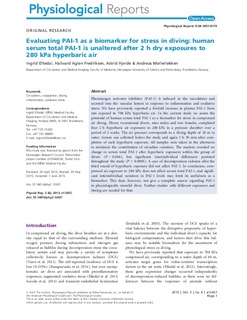| dc.contributor.author | Eftedal, Ingrid | |
| dc.contributor.author | Fredriksen, Hallvard Aglen | |
| dc.contributor.author | Hjelde, Astrid | |
| dc.contributor.author | Møllerløkken, Andreas | |
| dc.date.accessioned | 2015-06-12T06:16:42Z | |
| dc.date.accessioned | 2015-09-14T14:32:26Z | |
| dc.date.available | 2015-06-12T06:16:42Z | |
| dc.date.available | 2015-09-14T14:32:26Z | |
| dc.date.issued | 2015 | |
| dc.identifier.citation | Physiological Reports 2015, 3(6) | nb_NO |
| dc.identifier.issn | 2051-817X | |
| dc.identifier.uri | http://hdl.handle.net/11250/299784 | |
| dc.description.abstract | Plasminogen activator inhibitor (PAI-1) is induced in the vasculature and secreted into the vascular lumen in response to inflammation and oxidative stress. We have previously reported a fivefold increase in plasma PAI-1 from rats exposed to 708 kPa hyperbaric air. In the current study we assess the potential of human serum total PAI-1 as a biomarker for stress in compressed air diving. Eleven recreational divers, nine males and two females, completed four 2 h hyperbaric air exposures to 280 kPa in a pressure chamber over a period of 2 weeks. The air pressure corresponds to a diving depth of 18 m in water. Serum was collected before the study and again 3 h 30 min after com- pletion of each hyperbaric exposure. All samples were taken in the afternoon to minimize the contribution of circadian variation. The analysis revealed no change in serum total PAI-1 after hyperbaric exposures within the group of divers (P = 0.064), but significant interindividual differences persisted throughout the study (P < 0.0005). A case of decompression sickness after the third round of hyperbaric exposure did not affect PAI-1. In conclusion, com- pressed air exposure to 280 kPa does not affect serum total PAI-1, and signifi- cant interindividual variation in PAI-1 levels may limit its usefulness as a biomarker. This does, however, not give a complete answer regarding PAI-1 in physiologically stressful dives. Further studies with different exposures and timing are needed for that. | nb_NO |
| dc.language.iso | eng | nb_NO |
| dc.publisher | Wiley Open Access | nb_NO |
| dc.title | Evaluating PAI-1 as a biomarker for stress in diving: human serum total PAI-1 is unaltered after 2 h dry exposures to 280 kPa hyperbaric air | nb_NO |
| dc.type | Journal article | nb_NO |
| dc.type | Peer reviewed | en_GB |
| dc.date.updated | 2015-06-12T06:16:42Z | |
| dc.source.volume | 3 | nb_NO |
| dc.source.journal | Physiological Reports | nb_NO |
| dc.source.issue | 6 | nb_NO |
| dc.identifier.doi | 10.14814/phy2.12437 | |
| dc.identifier.cristin | 1247705 | |
| dc.relation.project | Norges forskningsråd: 220546 | nb_NO |
| dc.description.localcode | (c) 2013 The Authors. Physiological Reports published by Wiley Periodicals, Inc. on behalf of the American Physiological Society and The Physiological Society. This is an open access article under the terms of the Creative Commons Attribution License, which permits use, distribution and reproduction in any medium, provided the original work is properly cited. | nb_NO |
